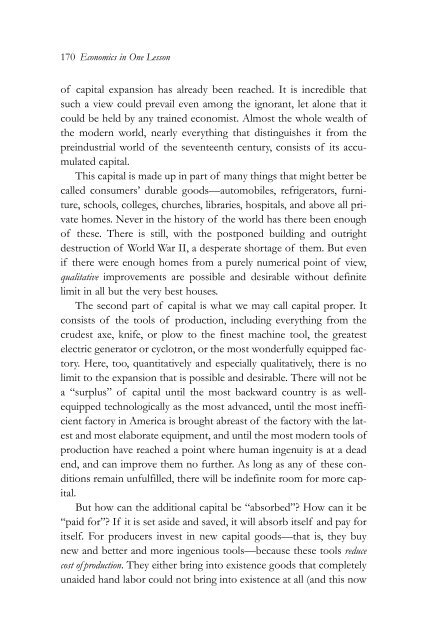1gDdM7w
1gDdM7w
1gDdM7w
- No tags were found...
You also want an ePaper? Increase the reach of your titles
YUMPU automatically turns print PDFs into web optimized ePapers that Google loves.
170 Economics in One Lessonof capital expansion has already been reached. It is incredible thatsuch a view could prevail even among the ignorant, let alone that itcould be held by any trained economist. Almost the whole wealth ofthe modern world, nearly everything that distinguishes it from thepreindustrial world of the seventeenth century, consists of its accumulatedcapital.This capital is made up in part of many things that might better becalled consumers’ durable goods—automobiles, refrigerators, furniture,schools, colleges, churches, libraries, hospitals, and above all privatehomes. Never in the history of the world has there been enoughof these. There is still, with the postponed building and outrightdestruction of World War II, a desperate shortage of them. But evenif there were enough homes from a purely numerical point of view,qualitative improvements are possible and desirable without definitelimit in all but the very best houses.The second part of capital is what we may call capital proper. Itconsists of the tools of production, including everything from thecrudest axe, knife, or plow to the finest machine tool, the greatestelectric generator or cyclotron, or the most wonderfully equipped factory.Here, too, quantitatively and especially qualitatively, there is nolimit to the expansion that is possible and desirable. There will not bea “surplus” of capital until the most backward country is as wellequippedtechnologically as the most advanced, until the most inefficientfactory in America is brought abreast of the factory with the latestand most elaborate equipment, and until the most modern tools ofproduction have reached a point where human ingenuity is at a deadend, and can improve them no further. As long as any of these conditionsremain unfulfilled, there will be indefinite room for more capital.But how can the additional capital be “absorbed”? How can it be“paid for”? If it is set aside and saved, it will absorb itself and pay foritself. For producers invest in new capital goods—that is, they buynew and better and more ingenious tools—because these tools reducecost of production. They either bring into existence goods that completelyunaided hand labor could not bring into existence at all (and this now


